Buttercream Milk Frosting
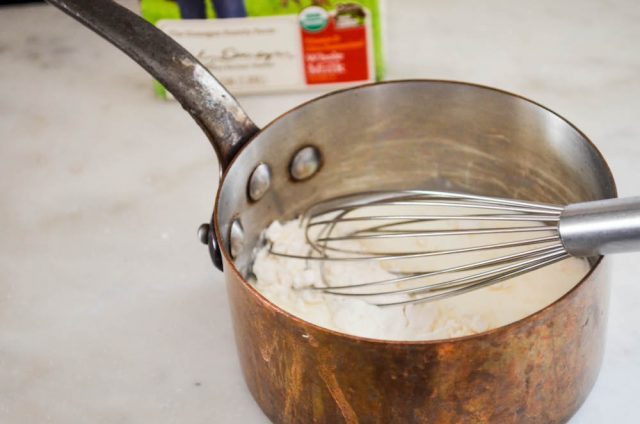
I’m not one to proclaim my recipes the best above all others, and yet, I did just that in my cookbook, Homemade with Love, when I wrote about vanilla buttercream frosting (actually, I titled it the The Best Vanilla Buttercream). Compared to the classic version, which I find cloyingly sweet, that incarnation is really the best vanilla buttercream, at least according to my taste buds.
And yet, there’s room to grow when it comes to making buttercream frostings. That’s where this rather old-fashioned approach to making frosting comes in. I first started making milk frosting about 10 years ago when I made red velvet cakes often (it’s one of Isabella’s favorites). While many people think of cream cheese as the classic red velvet cake pairing, I was smitten the first time I ever tasted it with a milk-based frosting. Still, I never really pulled out that frosting hat trick for other types of cakes until about six months ago.
So, let’s start with the question likely on many of your minds—what is milk frosting? Milk frosting is a cooked frosting. You begin by cooking milk with some flour and vanilla, a sweet roux, of sorts, on the stovetop.
Once the milk turns into a pudding-like consistency, you scrape it into a bowl, then cover it with plastic film and let it cool completely, making sure the wrap presses against the top of the mixture to prevent a pudding “skin” from forming on top. Using a sheet pan to spread it in a thin layer instead of a bowl helps speed up the cooling process.
After the thickened milk cools, you cream butter and granulated sugar until light and fluffy. This is another defining characteristic of milk frosting. Yes, you use granulated sugar, not powdered sugar to make this Buttercream Milk Frosting.
Once the butter and sugar are properly creamed, in goes the cooled, thickened milk. Making frosting in this method produces the lightest, fluffiest, and most importantly to me—a more balanced buttercream.
If you realize at this point that you forgot to cover your milk with plastic film, and it’s formed a skin, discard it and start over (the butter will keep, and might just need to be beaten again before adding the milk). It happens—it has happened to me when I’m rushing, but trust me when I say you don’t want to rush so much that you add that pudding skin to your creamed butter. It’ll result in a lumpy, odd textured frosting.
The cake I most often use this on, besides red velvet, is this chocolate cake. It conjures memories of Devil Dogs and Ring Dings from my childhood, just drizzle chocolate ganache on top like I did in the photo below. No worries, though, it’s perfect with golden vanilla cake, too. In fact, if you love carrot cake, but dislike cream cheese frosting, this Buttercream Milk Frosting would be a great stand in.
Eight Years Ago: Homemade Hot Cocoa
Seven Years Ago: Peanut Butter Bon Bons, Crispy Potato Latkes
Six Years Ago: Chocolate Gingerbread Doughnuts
Five Years Ago: Homemade Eggnog
Four Years Ago: Crispy, Chewy Gingersnap Cookies, Candied Pecans
Three Years Ago: Gingerbread Chess Pie
Two Years Ago: Peppermint Fudge Brownies, Slow Cooker Lentil Soup, Gingerbread Scones
One Year Ago: Almond Milk Eggnog, Asian Vegetable Noodle Soup, Homemade Almond Paste (without egg whites)
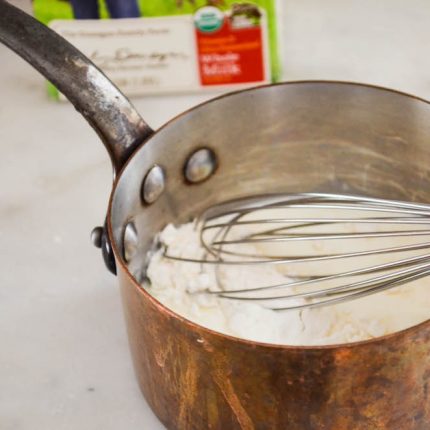
Buttercream Milk Frosting
Ingredients
- ½ cup milk
- ½ teaspoon vanilla extract
- 2 tablespoons 18 grams flour
- ½ cup 112 grams |1 stick butter, softened
- ½ cup 100 grams granulated natural cane sugar
- Combine the milk extract and flour in small pot over medium heat. Cook, whisking constantly, until mixture has thickened considerably, almost pudding-like, about 2 minutes. Remove from heat. Pour into a bowl, press a piece of plastic film onto the thickened milk so a “skin” doesn’t form. Set in a cold spot to cool completely.
- Meanwhile add the butter and sugar to a bowl. Beat until creamy, 3 to 5 minutes. Scrape the cooled milk mixture into the bowl. Beat until light & fluffy, about 5 minutes. Use immediately, or store in the fridge up to 3 days. Bring to temperature before using.
Instructions
- Makes enough to frost a 6-inch (two-layer) cake)
- ½ cup milk
- ½ teaspoon vanilla extract
- tablespoons (18 grams) flour
- ½ cup (112 grams |1 stick) butter, softened
- ½ cup (100 grams) granulated natural cane sugar
- Combine the milk, extract and flour in small pot over medium heat. Cook, whisking constantly, until mixture has thickened considerably, almost pudding-like, about 2 minutes. Remove from heat. Pour into a bowl, press a piece of plastic film onto the thickened milk so a “skin” doesn’t form. Set in a cold spot to cool completely.
- Meanwhile, add the butter and sugar to a bowl. Beat until creamy, 3 to 5 minutes. Scrape the cooled milk mixture into the bowl. Beat until light & fluffy, about 5 minutes. Use immediately, or store in the fridge up to 3 days. Bring to temperature before using.

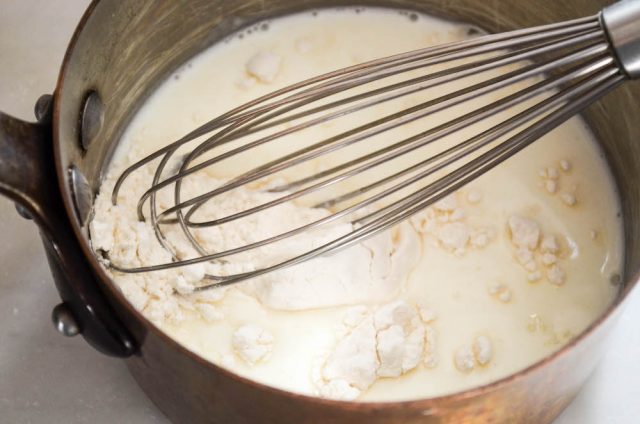
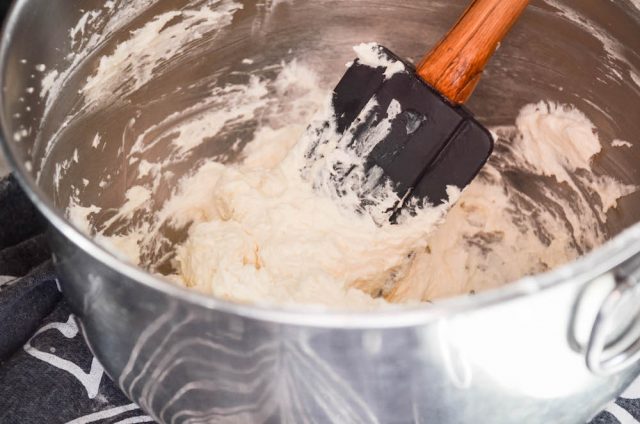
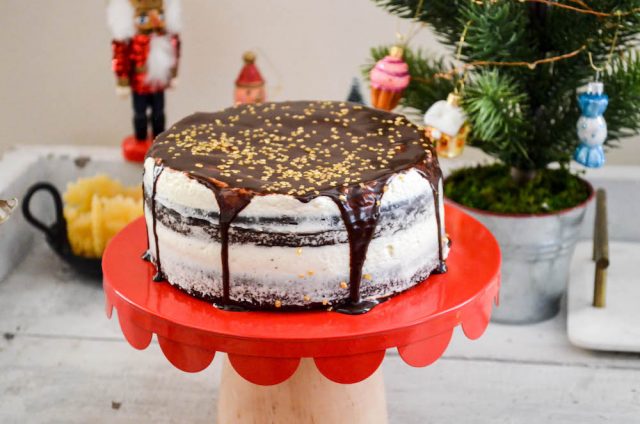
Delora
Ooh, I’ll have to give this a try. My gold standard frosting is an egg white buttercream (where you whip the hot sugar syrup into foamy egg whites and add butter; I guess some people call that Italian Buttercream?), but it’s almost too decedent, and takes an awfully long time to cool.
Jennie
Yes, Delora. That’s Italian Buttercream, and I love it, too, but as you said, a bit more time consuming. xo-Jennie
MaryLouise
This is the only frosting weve ever used on Red Velvet cake. I think the recipe came from the Waldorf Astoria many, many years ago. I’m not sure where the cream cheese frosting became the frosting of choice, —never at our home, it is too heavy for this cake, and we live in the South– Also, Adams Extract Company, had a tear off recipe near the extract, spices display with the recipe for Red Velvet cake and this luscious frosting. That is where my Mom acquired the recipe. It’s not new, I am quite old and my mother used this recipe—so at least 50 years ago. Some call it French Buttercream, and yes, it is very yummy. One thing I do when making it, I strain the milk/flour mixture before I cook it to make sure there are no lumps, then stir constantly with a whisk. Thanks, Jenny for sharing this yummy recipe with your readers—-yes, also delicious on chocolate cake as you stated, I even use it on coconut cake. Yum!!!
Lucie
Hi Jennie! This is a terrific frosting. I’ve known it as Gravy Icing and its topped my daughter’s chocolate birthday cake every one of her 34 years. I came across the recipes as Bradley Ogden’s January Cake and Gravy Icing in a column of Marion Cunningham’s way back then. The dense sweetness of both together is marvelous!
jodi
hi jennie – this sounds delightfully intriguing. I’d love to try it…
just wondering if you’ve ever tried doubling the recipe? if not, do you think it’d work? I’d like to make a cake larger than 6″ rounds.
thanks!
Jennie
Hi Jodi,
Yes, you can absolutely double the recipe. I do it often.
xo-Jennie
Joey
I believe this is also known as Ermine Frosting. Gross name but a delicious frosting that I love. I feel the same way about the usual overly sweet, powdered sugar loaded buttercream frosting.
asha
what I love most about ermine or milk frosting is that you can infuse the milk with flavors that can otherwise difficult to incorporate (I’ve done this with ginger as well as cardamom successfully, and I’m sure it would work with cinnamon as well).
Jennie
Oooh, I love that tip. Thank you! xo-Jennie
Bobbi
you stated you poured ganache over the buttercream on your cake. How do you do that so the ganache doesn’t melt the buttercream. You can tell I am new at this!
Jennie
You just let the ganache cool enough until it gets to a stage where it’s still pourable but not hot. -Jennie